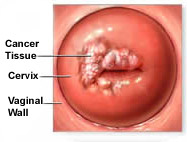| Types | Causes | Symptoms | Diagnosis | Stages | Treatment |
 Cervical cancer
or cancer of the cervix is an abnormal growth of malignant (cancer) cells
in the cervix. It is the second most common cancer in females and it is successfully
curable in the early stages. Cervical cancer occurs most commonly between
40 and 55 years of age.
Cervical cancer
or cancer of the cervix is an abnormal growth of malignant (cancer) cells
in the cervix. It is the second most common cancer in females and it is successfully
curable in the early stages. Cervical cancer occurs most commonly between
40 and 55 years of age.
The cervix is the opening
of the uterus connected to the upper vagina. It is known as
the neck of the uterus. The lower end of the cervix has an opening called the
external os, and before childbirth it is about 5mm in diameter. It dilates to
10cm during labour to allow for childbirth and never regains its former
shape, changing to a slit approximately 7mm long. Normally the cervix is
pink in colour but turns bluish in pregnancy because of an increased blood supply.
Note : All
statements given are only for information purpose. We are not
responsible or liable for any problems related to the utilization of
information on this site. We suggest that you consult a qualified
doctor before trying any alternative health care remedies.
 Sometimes
abnormal cells develop in the breast tissue, forming a lump or tumor. This is
the most common type of cancer in women.
Sometimes
abnormal cells develop in the breast tissue, forming a lump or tumor. This is
the most common type of cancer in women. 


























